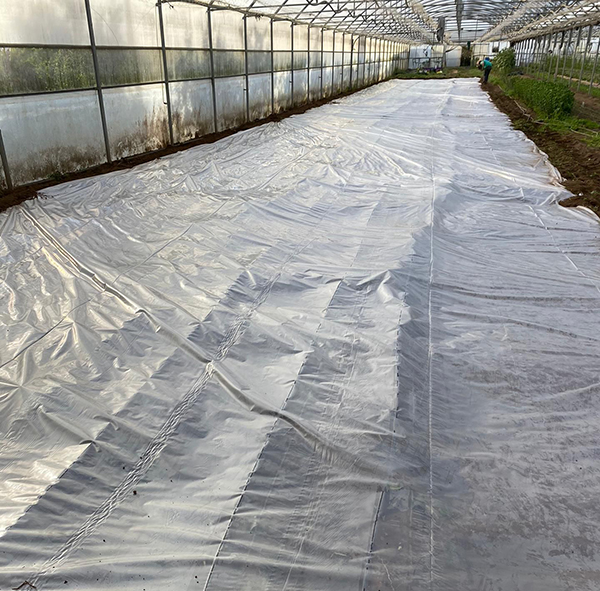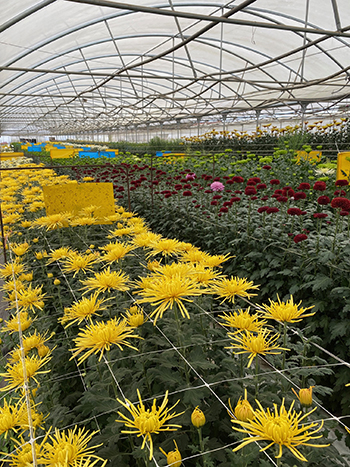Florista Lina farm is a family owned company started more than 20 years ago. It is situated in Barcelos, in the northern region of Portugal. Of the l50 acres, only a bit over 4 acres are being used now for flower production.

In the greenhouses at Florista Lina farm in Barcelos, Portugal. All photos courtesy of the author.
This company was started by our grandparents when they acquired land to grow vegetables and fruit such as tomatoes, peppers, potatoes and melons. At that time both of their daughters were working at a factory, but years later they decided to take over the business and change it bit by bit to flowers. They built greenhouse structures. A few years ago, the third generation took over with the goal to be more productive and more sustainable.
Rewind to 20 years ago, and it was the golden era for chemicals. Everything was allowed, there were no restrictions and there was no concern for the toxicity to humans or the the environment. Growing crops like melons that are highly susceptible to fusarium was easy with chemical soil treatments.
Portugal’s laws started to get very strict after the 2010s, and many of the chemicals were banned even before the European restrictions. Without an option to use chemicals to disinfect — and steaming isn’t something we can afford — many growers closed or had to change their methods.
When I took over the business I noticed right away that our soil was problematic. One of the major problems was the verticilium, which was affecting several crops. We didn’t lose many chrysanthemums since it’s an autumn crop, and in the fall the disease isn’t that severe.
However, with snapdragons I had 100 percent losses in some areas. It was terrible. Everyone in agriculture should be expecting plant losses. Up to 10 percent to 15 percent can be acceptable, but more than that means most of your profit is already gone.
During a discussion with some colleagues from Israel, they advised and introduced me to the biofumigation process. At the core of biofumigation is the use of specific plants as natural pest control agents. Preferentially, brassicaceae crops are used, including mustard, broccoli, and radish. When broken down, those crops release sulphur-conaining phytochemicals called glucosinolates, and when mixed with water it leads to the production of isothiocyanates (ITC). It is these isothiocyanates that act as potent biocides, targeting a wide spectrum of soil-borne pests, diseases, and weeds.
The biofumigation process
The process of seed selection is crucial, with various seed types tailored to specific environments. We worked with Tozer Seeds in England, because they breed seeds for biofumigation in varying environmental conditions. On a smaller scale, as in our case, manual sowing is used, followed by thorough irrigation. Within the first week, germination begins.

Germinating mustard seedlings for biofumigation.
The entire process typically takes about eight weeks under spring and summer conditions. While manual sowing is common, it can also be accomplished using a seeder. Throughout the growth cycle, the crop requires regular watering and feeding to foster optimal green manure development.
Important checkpoints include the formation of flowers around 45 days after sowing and approximately 60 days thereafter when roughly 50 percent of the flowers have opened, signifying the completion of the crop and readiness for shredding. If the crop doesn’t exhibit the expected percentage of flower openings by the eight-week mark, and you are in a hurry, you can go ahead and shred the crop. But if you are not in a hurry, if you can wait until the crop is 50% in bloom, by then it should be high in glucosinolates.

Approximately 60 days after sowing, when roughly 50 percent of the flowers have opened, signifying the completion of the crop and readiness for shredding.
Contrary to common belief that the glucosinolates are only present in the flowers, they are actually distributed throughout the entire plant. Therefore, it’s crucial to cultivate the crop well to produce as much biomass as possible. Greater biomass leads to increased production of ITC. The flowering stage serves as an indicator that the plant has reached its peak growth and will begin to decline thereafter.

Formation of flowers around 45 days after sowing.
The most critical aspect of the process is the rapid chopping and incorporation of green material into the soil to minimize the losses of gas. Research indicates that if more than 20 minutes pass after mowing the crop, 80 percent of gases are lost if not integrated into the soil promptly.
Therefore, we decided to work with two machines at the same time to mow and incorporate the biomass as quickly as possible. The first pass is with a flail mower to break down the crop as much as possible in order to maximize the release of glucosinolate. The second pass is with a rotavator to incorporate the enzymes into the soil so they can be broken down to ITCs.

Mustard biomass after flail mowing.
We also take this opportunity to solarize the soil. First, we saturate the soil and install irrigation pipes to keep the soil wet, and then install a thin layer of plastic. After two weeks of solarization, we remove the plastic, let the soil air for another two weeks and do the minimum work on that soil to plant the next crop.

Solarization after the flail-mowed mustard has been incorporated into the soil.
Benefits
In addition to the environmentally friendly aspect of “cleaning” the soil without harming soil microbes, compared to more traditional methods, biofumigation offers several benefits. Starting with crops like mustard can enhance these benefits. When we incorporate mustard or similar crops into the soil, we increase the organic matter content, thereby enhancing soil fertility. This increase in organic matter provides crops with more natural food sources, leading to improved performance. Overall, biofumigation not only helps in soil cleansing but also boosts soil fertility, contributing to better crop yields in a sustainable manner.

A bed full of biofumigation mustard.
In addition to the fact that we are cleaning the soil of pathogens in a sustainable and natural way, biofumigation has other benefits too. This process substantially reduces annual weeds, and saves a lot of labor. Bofumigation may also be able to help with some nematode problems, though we cannot say from experience since we don’t have problems with them.
Constraints
While biofumigation and similar methods offer numerous benefits, they also come with practical limitations. One significant drawback is the time-intensive nature of the process, especially when we are treating inside the greenhouses like we do. We need to be rotating as fast as possible to avoid the soil being without a profitable crop for a long period.
The process takes around three months in warm weather, which translates into a lot of money that could have been produced in the same space during that time instead of biofumigation. So, for some growers with limited space, this process may not be feasible.
Furthermore, and most importantly, we are talking about pest and disease suppression in the areas where the process is implemented. It doesn’t mean that those pathogens will be 100 percent eliminated, and we need to colonize that area as fast as possible with beneficial microbes to compete for the space. If this isn’t done, areas next to the treated area that didn’t experience suppression of pathogens will rapidly colonize the treated area and the effect of biofumigation will be less than what should be expected.

Flowers growing in healthy soil at Florista Lina.
An alternative for those with a lack of time and space inside the greenhouse who have outdoor growing space, is to grow the crop outside. Then, chop and collect the green manure and incorporate it into the soil inside the greenhouse. In this way we reduce the process time inside the greenhouse, but on the other hand it will require more equipment and it’s more labor intensive.
Biofumigation represents not just a method for pest control, but a transformative approach to agriculture — one that nurtures the soil, safeguards the environment, and secures a bountiful harvest for generations to come. As the agricultural landscape continues to evolve, biofumigation stands as a testament to the potential of marrying innovation with sustainability in the pursuit of a greener and more resilient future.
Bruno Maciel, an agricultural engineer who took over the family farm, channels his passion for farming into growing beautiful seasonal flowers sustainably. Follow his instagram @floristalinafarm for the latest on his innovative, eco-friendly floral ventures.
